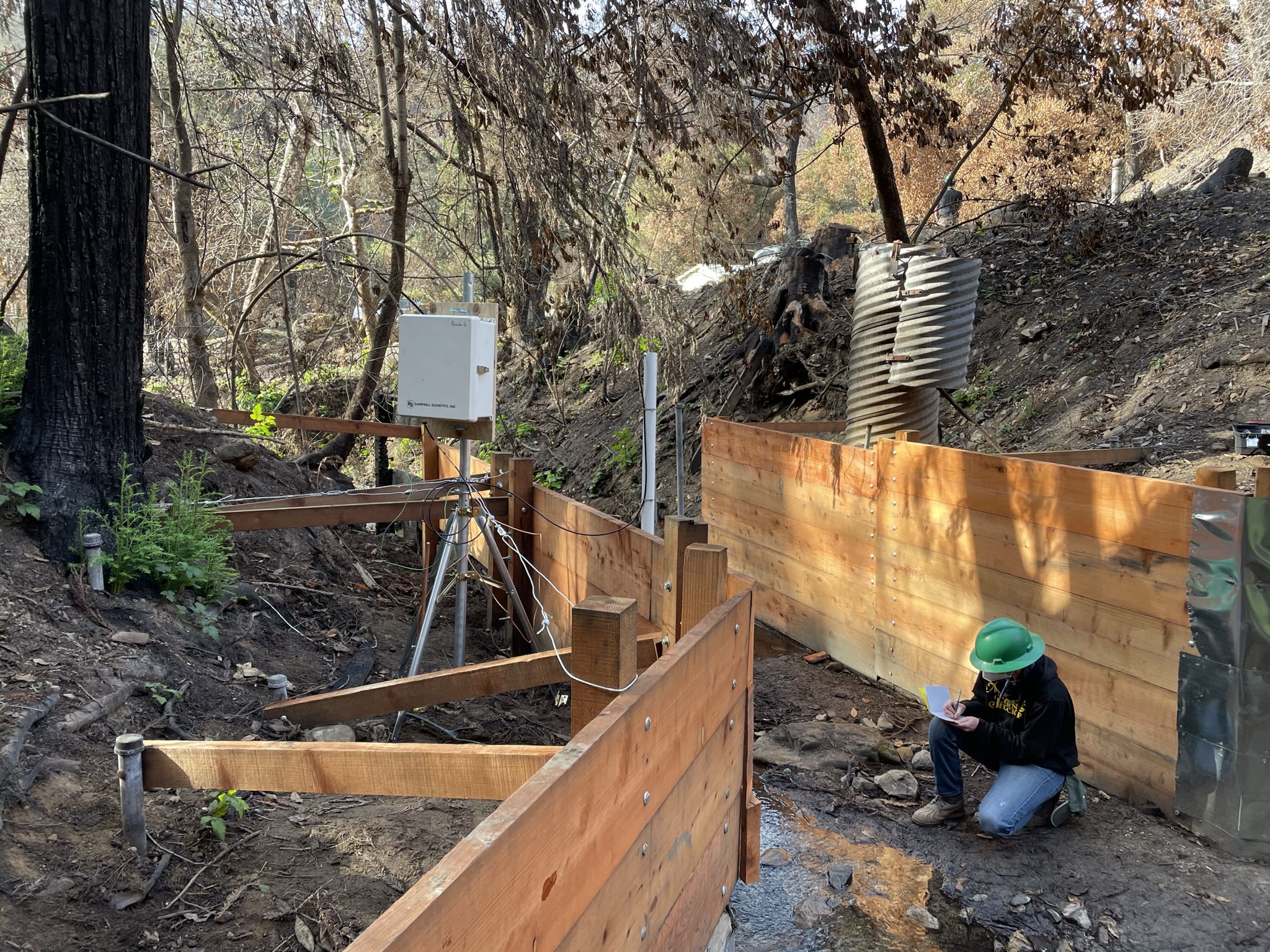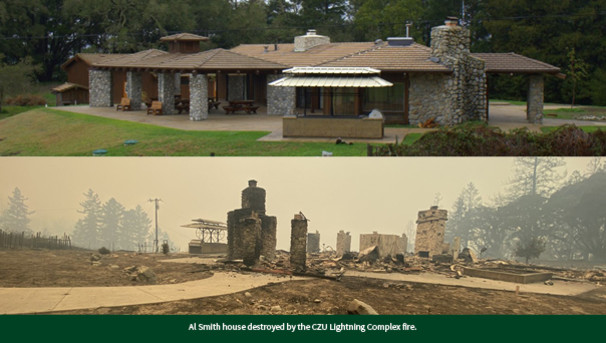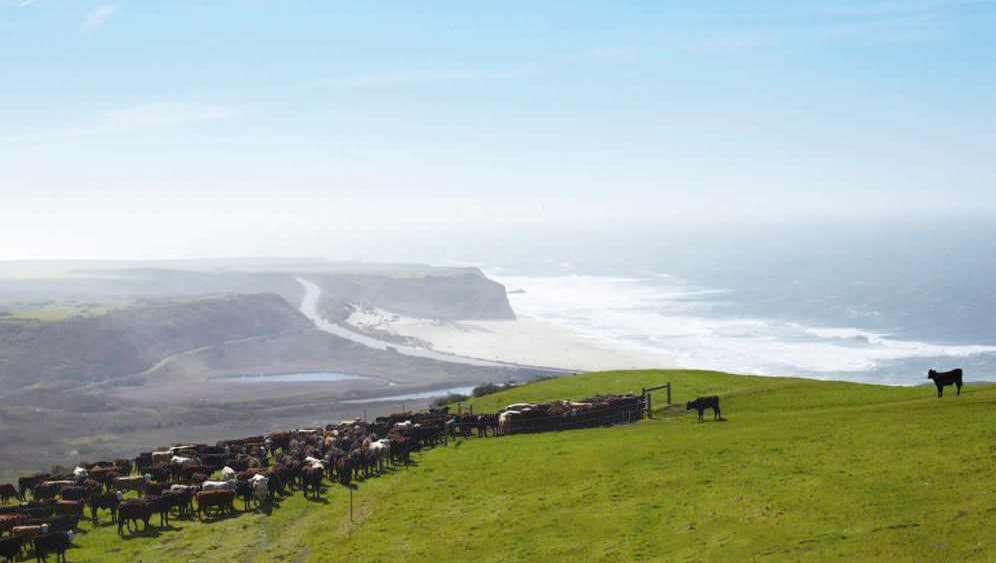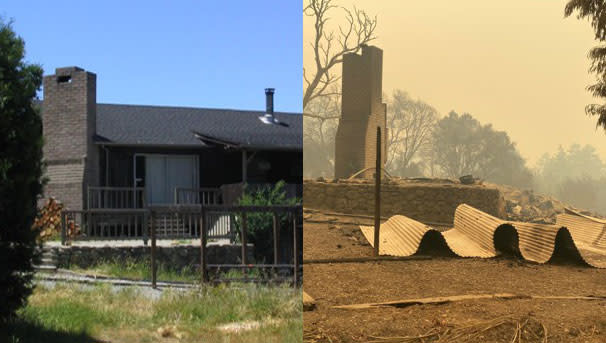Thank You!
The first phase of this campaign has concluded. We are currently planning the strategic vision for the future of Swanton Pacific Ranch, but you can still make a gift to support our ongoing recovery efforts at the ranch or Swanton Pacific Railroad by clicking here.
The Latest News from Grey Hayes, education and research coordinator, on the Swanton Pacific Ranch Recovery Process
Swanton Pacific Ranch welcomes a wet winter with lots of work ahead. Our first rains were a month ago, but since then nothing but drying wind – until December 12 when things got rainy again and we watch as the fields begin to green. We won’t have any cattle back for some time as the fences and livestock watering systems still need extensive repair from the fire. But, out on the rangeland a different sort of action: research! Swanton Pacific Ranch’s Agricultural Management Specialist Aaron Lee is becoming another example of the ranch’s Learn by Doing contributions, not only helping Professor Stewart Wilson with a cutting-edge research project, but he is also entering the graduate program in the Natural Resources Management and Environmental Sciences Department. Lee has been hard at work spreading nearly 200 tons of compost in 24 carefully placed treatment plots in the artichoke pastures. Meanwhile, Wilson finished an exhaustive baseline soil sampling for the project. We’ll soon know more about our rangeland soils than ever before, and students in the campus soils lab will get hands-on training in lab routines.
The research isn’t all in the rangeland — there’s plenty of research taking place in the Little Creek basin. For instance, this past (rainy) weekend, Professor Chris Surfleet placed stream monitoring devices in Little Creek and in other Scott Creek tributaries to monitor stream height. His graduate student, Ky Dupuis, joined with the (soggy) work and will return throughout the winter to monitor precipitation and stream characteristics.
The CZU Lightning Complex Fire is still very much on our minds. Given the only very recent rains, the ranch still looks quite bleak: the browns and blacks of post fire dominate the landscape. With shortening day length, growth rate has slowed with resprouting redwoods and brush. Hungry deer and/or woodrats are browsing heavily on tan oak sprouts. Some redwoods are pushing tiny green shoots out of their blackened trunks, and way, way up, post-fire bottle brush trees are forming. When we ask our National Oceanic and Atmosphere Administration colleagues about the fish, they say they had good counts way up in the streams – the young, rare fish survived the fire!
Behind the scenes, staff are busier than ever. We are down to five staff now (we had 10 before the fire) due to retirements and season employment. Half the staff and quite a bit to do! Besides supporting research, we are working on the cleanup and repairs. Soon, we will have internet service back at our office. Also, we hope to soon see some additional debris removal. A metal scrap recycling contractor has been hauling off hulks of burnt up metal or machinery. Along Swanton Road, the utility line and culvert/bridge crews have wrapped up and it is easier, and safer, to pass. Thanks to our eternal heroes at the Resource Conservation District of Santa Cruz County, any sites that burned near streams were contained with straw and such before the rains.
Photo caption: Ky Dupuis works near the newly installed streamflow equipment.

An Update from Staff on the Swanton Pacific Ranch Recovery Process
While post fire wildlife and vegetation rebounds, Swanton Pacific Ranch associates are understanding the impacts of the fire facilities and natural resources to chart the best way towards recovery. Our walks through the forest and rangelands help us to see the resilience of native species. Fresh, tan wood showing through blackened trunks: evidence of the prolific and diligent work of four species of woodpeckers. Resprouting tan oak is frequently browsed by deer, rabbit, and woodrat. Redwoods, bays, and even nutmeg are resprouting where trunks meet the charred earth. Ravens caw and peregrine falcons and other hawks gyre over our office building (Casa Verde) in great numbers. And, through all this natural wonder, us humans studiously make plans for the very best next steps and learn from what happened.
There is a lot of solo work, but also many great minds coming together at the ranch. We plan, make lists and calls, and then meet with numerous people in the effort to clean up and understand insurance negotiations. Field staff repair scientific instrumentation and infrastructure, facilitating a surprising coalescence of research interest in post fire dynamics. We also meet with our extended network of advisors, considering where we go from here. Dean Andy Thulin recently convened new staff at the Ranch: Associate Dean Cath Klier and Natural Resources Management and Environmental Sciences Department Head Jeremy James. We’ve also had visits by our partners at TomKat Ranch, as well as meetings with many expert foresters, including 20 highly supportive and influential Cal Poly/Swanton Pacific Ranch alumni.
Despite the fire and the pandemic, students and professors are especially engaged with Swanton Pacific Ranch. We have students, professors, and other partners flying drones to capture images of fire effects. Jacob Dixon, a student living locally with his family has helped to monitor grazing and fire effects on rangeland forage, part of Professor Marc Horney’s long-term annual monitoring program. We have students signing up as interns to help create curricula related to regenerative land management at the ranch. Students are also getting hired to help with soils analysis as part of our rangeland soils health research. And, a student team is working with Cal Poly librarian Jeanine Scaramozzino to create a user-friendly Q&A computer interpretation program to help greet and engage future ranch visitors. The National Oceanic and Atmospheric Administration staff are back at the fish weir capturing salmonids. Geologists are getting ready to monitor how the rains will affect the fire-bared slopes. We keep up with all of this excitement and look forward to a formal strategic planning process beginning early next year.


What Swanton Pacific Ranch and Railroad Means to Us
Please click here or below watch a video and hear more about what Swanton Pacific Ranch means to those who work and study there and their hopes for the future.
A Message from Staff on Swanton Pacific Ranch
It’s hard to believe the CZU Lightning Fire Complex hit Cal Poly’s Swanton Pacific Ranch just over a month ago. We still find ourselves shocked at the losses – the homes especially, but also our teaching spaces, our favorite trails, and tools and equipment that we took for granted. Yet our team, like the land we steward, is resilient and we are making fast progress toward recovery. Perennial grasses have already resprouted with luxuriant six-inch blades, shrubs and trees are quickly growing shoots from the base of their charred trunks.
Before the fire, daily ranch life was already on a different rhythm because of COVID-19. Field trips were limited, events canceled, and we were missing the smiling faces of students. Yet we learned how to stay connected from afar. Professors transitioned to including the ranch’s forests, creeks, and rangelands in classes virtually. Now, they need new visuals and stories: more work, more opportunity! Forestry classes need photos of charred redwood stands with ashy understories and we will learn together from our emerging salvage forestry plans led by Nadia Hamey, our long-term forester-advisor. Our rangeland management classes can “huddle” around the screen with us as we create new fence lines and think about reintroduction of evacuated livestock (and how to use ruminants to reduce resprouting brush).
Meanwhile, our staff are slowly returning to the ranch as power and internet are restored. Associate Director Mark Swisher (Animal Science, ‘03), who joined us last year, is supervising our teams to inventory losses, create temporary staff housing, and plan for the next steps of engagement in teaching and research. We are very thankful for the outpouring of support from our Swanton Pacific Ranch and Cal Poly communities.
Grey Hayes, Education and Research Coordinator
Cortney Newby (Agricultural Science, ‘03), Administrative Support
An Update on Swanton Pacific Railroad
Click here to read about the future of Cal Poly's historic Swanton Pacific Railroad.
Thank you so much for your support.
Another Update on the Swanton Pacific Ranch
History of Swanton Pacific Ranch
A compelling story on the history of Swanton Pacific Ranch by Mercury News can be read here:




